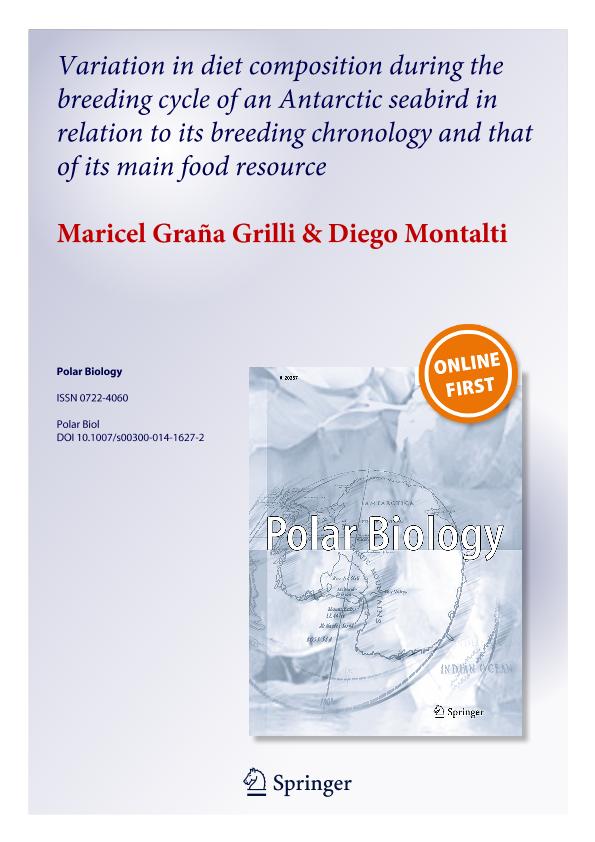Mostrar el registro sencillo del ítem
dc.contributor.author
Graña Grilli, Maricel

dc.contributor.author
Montalti, Diego

dc.date.available
2018-02-14T18:27:17Z
dc.date.issued
2014-11
dc.identifier.citation
Graña Grilli, Maricel; Montalti, Diego; Variation in diet composition during the breeding cycle of an Antarctic seabird in relation to its breeding chronology and that of its main food resource; Springer; Polar Biology; 38; 5; 11-2014; 643-649
dc.identifier.issn
0722-4060
dc.identifier.uri
http://hdl.handle.net/11336/36445
dc.description.abstract
This work had two aims related to the diet of brown skuas (Stercorarius antarcticus lonnbergi) breeding at Laurie Island (South Orkney Islands, Antarctic). The first aim was to explore whether there are changes throughout the breeding season. The second aim was to determine whether those changes relate to differences in food resource availability of their main prey, penguins, at different time periods of the penguins’ breeding cycles, or to different moments of the skuas breeding cycle, which may variably restrict the foraging activities of parents. Diet was analyzed from pellet samples grouped in two different ways. They were grouped in three periods defined for the skuas breeding cycle (laying and incubation; early parental care; later parental care), or the pellets were assigned to five periods based on the type of food resources available at the penguin colonies (eggs; eggs and small chicks; small and large chicks; large and fledged chicks; fledged chicks). A temporal variation in diet composition was evident from the analysis of contingency tables for both sample grouping methods. The more represented item in every period for both analyses was adult penguins, which may be related to the proposed cleaning function of the gut of penguin feathers. Both ways of grouping the samples suggest a relationship between the kind of resources available at the penguin colonies and the easiness of delivering them to the skuas chicks, reflected in a successive predominance of use of penguin eggs first and of penguin chicks and other birds later.
dc.format
application/pdf
dc.language.iso
eng
dc.publisher
Springer

dc.rights
info:eu-repo/semantics/openAccess
dc.rights.uri
https://creativecommons.org/licenses/by-nc-sa/2.5/ar/
dc.subject
Brown Skua
dc.subject
Diet Study
dc.subject
Pellets
dc.subject
Resource Availability
dc.subject
Stercorariusantarcticus Lonnbergi
dc.subject.classification
Otras Ciencias Biológicas

dc.subject.classification
Ciencias Biológicas

dc.subject.classification
CIENCIAS NATURALES Y EXACTAS

dc.title
Variation in diet composition during the breeding cycle of an Antarctic seabird in relation to its breeding chronology and that of its main food resource
dc.type
info:eu-repo/semantics/article
dc.type
info:ar-repo/semantics/artículo
dc.type
info:eu-repo/semantics/publishedVersion
dc.date.updated
2018-02-14T13:19:52Z
dc.journal.volume
38
dc.journal.number
5
dc.journal.pagination
643-649
dc.journal.pais
Alemania

dc.journal.ciudad
Berlin
dc.description.fil
Fil: Graña Grilli, Maricel. Consejo Nacional de Investigaciones Científicas y Técnicas; Argentina. Ministerio de Relaciones Exteriores, Comercio Interno y Culto. Dirección Nacional del Antártico. Instituto Antártico Argentino; Argentina. Universidad Nacional de la Plata. Facultad de Ciencias Naturales y Museo. Departamento Científico Zoología Vertebrados; Argentina
dc.description.fil
Fil: Montalti, Diego. Consejo Nacional de Investigaciones Científicas y Técnicas; Argentina. Ministerio de Relaciones Exteriores, Comercio Interno y Culto. Dirección Nacional del Antártico. Instituto Antártico Argentino; Argentina. Universidad Nacional de la Plata. Facultad de Ciencias Naturales y Museo. Departamento Científico Zoología Vertebrados; Argentina
dc.journal.title
Polar Biology

dc.relation.alternativeid
info:eu-repo/semantics/altIdentifier/doi/http://dx.doi.org/10.1007/s00300-014-1627-2
dc.relation.alternativeid
info:eu-repo/semantics/altIdentifier/url/https://link.springer.com/article/10.1007%2Fs00300-014-1627-2
Archivos asociados
